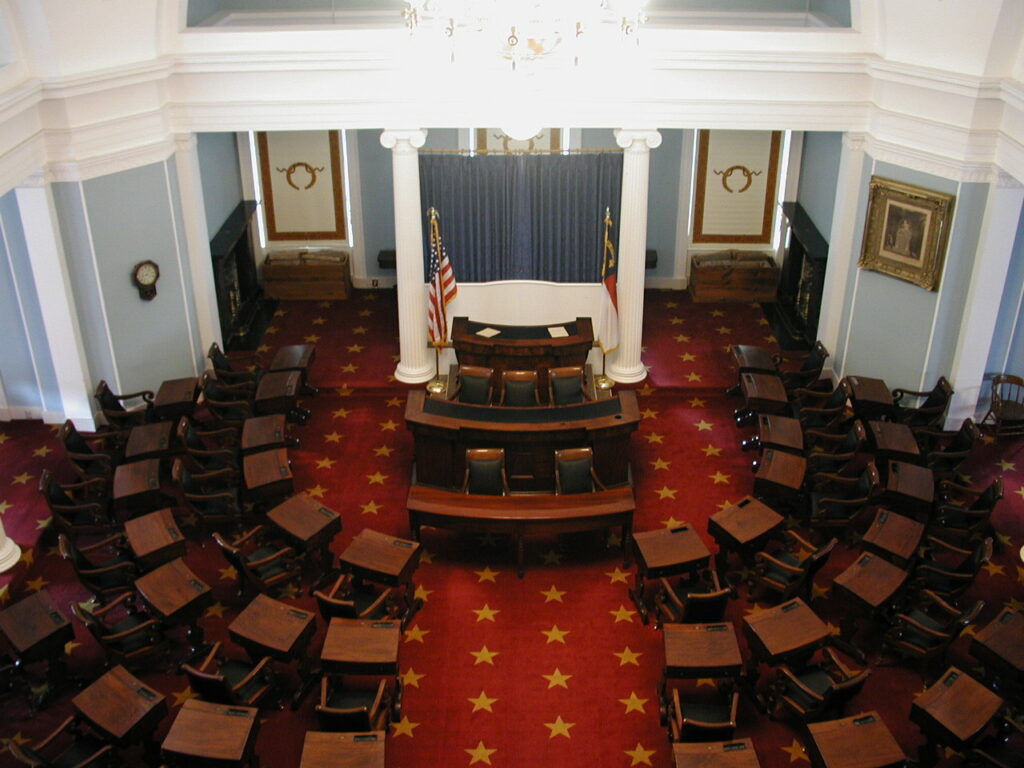What is a “district?”
Most of our federal and state legislators, and many of our local legislators in our towns and counties are elected from districts.
Sometimes, a district is the same as a jurisdiction– for example, a school board might be elected from the same geographic location as the actual schools that are governed by the board. Often, however, districts subdivide a territory so that there are several districts within one city or state, and representatives are elected from each separate district. How those lines are drawn is pretty serious business and can impact who gets elected.

What do districts mean for North Carolina and our elections?
North Carolina currently comprises of:
- 13 United States congressional districts (these are the elected officials that go to Washington DC to represent us)
- 50 state senate districts and 120 state house districts (these are the elected leaders who go to Raleigh to represent our local communities).
State senators and state representatives are elected every two years in partisan elections.
What is “redistricting?”
Redistricting is the way we draw those lines and change the districts that determine who represents us. In practice, it is the redrawing of a district’s boundaries (on actual maps) to determine where people elect their representatives to the U.S. House of Representatives, state legislature, county or city council, school board, etc. In other words, it’s creating groups on a map where people will vote together.
When does redistricting happen?
Did you participate in the census last year? If so, your information is being used to determine new districts for the next 10 years in North Carolina. It’s critical to make sure your information is being used fairly to help you and your interests get representation, lest they be divided out from people who might vote like you.
State legislative redistricting must take place in the first regular legislative session following the United States Census. The Census is taken every ten years at the beginning of a new decade. The population data from that census is supposed to be evaluated to redraw fair districts.

Who is responsible for redistricting?
The NC General Assembly is responsible for drawing both congressional and state legislative district lines. Unlike most actions of the NCGA, the maps cannot be vetoed by the Governor. What this means in NC is that because the NCGA is controlled by one party right now (Republicans), that party gets to draw the maps. However, the public can– and should— weigh in! More on that later.
So, what is “Gerrymandering?”
Gerrymandering is the practice of setting boundaries of electoral districts to favor specific political interests within legislative bodies, often resulting in districts with convoluted, winding boundaries rather than compact areas. In other words, it’s politicians carving up maps to make sure that communities vote in a certain way. The purpose of gerrymandering is to distort representation. Yikes.
How is redistricting SUPPOSED to happen?
Federal law says that the shape of a district cannot block minority groups from electing candidates of choice.
North Carolina law requires that districts be contiguous, compact, and “must cross county lines as little as possible.” If counties are grouped together for a district, the group should include as few counties as possible and follow natural lines of the counties or other natural boundaries. State law also says that communities of similar interest should be considered and kept together so as not to dilute or divide their voting power.

Source: Princeton Election Consortium
How does redistricting impact issues that matter to me?
How districts are drawn can either divide up or pull together voting power.
Redistricting has a direct impact on political power– it significantly determines who can gain power through elections. In North Carolina, the shape of a district significantly determines who represents us in D.C., in Raleigh, and locally.
By extension, redistricting can determine what issues a legislature chooses to tackle and which they ignore. In other words, if you care about having our state raise the wage or address affordable housing or pass Medicaid expansion, how our districts are drawn are going to help determine if our representatives even take these issues on.
How does redistricting impact the voice of diverse communities?
Redistricting also affects whether our state’s diverse communities are represented in legislative bodies. If fair lines are drawn, redistricting can ensure that communities of color have a fair shot at electing candidates who represent their worldview and will fight for what they need. Of course, depending on who is drawing the lines and how, it can also carve up and dilute the votes of these communities and exclude them from having a seat at the table.
What can we do?
Learn more about redistricting and try your hand at drawing maps for North Carolina here: https://districtr.org/north-carolina
Get involved! North Carolina does allow public input into the drawing of maps. Make sure your elected officials know you are watching and that you have an opinion! Get involved with the work of All on the Line to learn more about how you can use your voice to impact fair maps!



